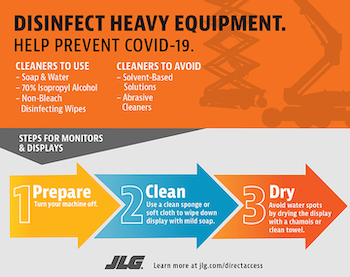Service Tips -- Equipment hygiene
Help prevent the spread of COVID-19 by properly cleaning lift and other equipment.
By Mark Vaughn
With the continued spread of COVID-19 worldwide, equipment cleaning has taken on a new importance in helping to prevent the spread of this novel coronavirus.
 |
Since the onset of the pandemic, equipment manufacturers like JLG have been getting many questions about how to protect people from contracting the virus on job sites through proper machine cleaning methods of lift equipment. The equipment washing guidelines in this article are meant to help you safely disinfect machines while maintaining the integrity of the units.
CDC guidelines
There are several steps you can take every day to prevent the spread of COVID-19 on job sites, including action items recommended by the CDC.
Step 1: Develop a plan
- Determine what needs to be cleaned
- Determine how areas will be disinfected
- Consider the resources/equipment needed
Step 2: Implement the plan
- Clean visibly dirty surfaces with soap and water prior to disinfection
- Use the appropriate cleaning or disinfectant products
- Always follow the directions on the cleaning or disinfectant products’ labels
Step 3: Maintain and revise the plan
- Continue routine cleaning and disinfection daily
Cleaning and disinfecting best practices
It is important that everyone on your job site maintains safe practices, such as frequent handwashing, wearing masks and staying home if they are sick. Other measures to continue to practice include maintain social distancing by staying six feet away from others, as well as reducing sharing of common spaces and frequently touched surfaces.
When cleaning equipment, follow guidance from the CDC:
- Wear disposable gloves to clean and disinfect and discard after use or use reusable gloves that are dedicated only for cleaning and disinfecting. Always wash hands after removing gloves.
- Clean any dirty surfaces using soap and water first, then use disinfectant.
- Cleaning with soap and water reduces the number of germs, dirt, and impurities on the surface. Practice routine cleaning and disinfection of frequently touched surfaces. More frequent cleaning and disinfection may be required based on level of use.
- After cleaning equipment, the CDC recommends disinfecting it with a disinfectant on the EPA list for COVID-19. Follow the instructions on the label to ensure safe and effective use of the product. Many products recommend:
- Keeping the surface wet with disinfectant for a period of time recommmended on the product label.
- Take precautions such as wearing gloves and having good ventilation while using the product.
- Before cleaning anything, make sure you read and understand all directions and hazards found and described on the labels and material safety data sheet of any chemical.
- Ensure the cleaning agent/chemical is recommended for use on the intended surfaces.
Recommended equipment cleaning products
Help protect the health of your customers and staff by cleaning your machines between every use with the right chemicals and tools. To minimize any adverse effects on machine components during cleaning, JLG recommends using the following types of products:
- Soap and water, used per Health Organization guidelines
- 70 percent isopropyl alcohol, such as isopropanol with a prepackaged wipe cloth
- Non-bleach disinfecting wipes (preferred) or spray
- Avoid using solvent-based solutions or abrasive cleaners to prevent damage to sensitive components.
Cleaning monitors and equipment displays
It’s important to clean monitors and displays that are in close proximity to equipment operators; they require additional precautions. Don’t scrub or use brushes on the display window, and avoid the use of abrasive cleaners or solvents that may damage the display window.
JLG recommends cleaning lift equipment displays this way:
- Turn the machine off.
- Use a fresh sponge or a soft cloth to clean the display with a mild soap or detergent, or with products deemed safe for monitors and displays.
- To avoid water spots, dry the display with a chamois or clean towel.
FAQ RE: Cleaning and disinfection
Staying diligent to established equipment cleaning practices is the best way to reduce the potential for exposure to COVID-19. To make sure everyone on your job site understands what they need to do to stay safe Most frequently asked questions:
Q. How often should cleaning be done?
A. Minimum suggestion is to clean at every change of operator. Final decision should be determined by the machine user.
Q. How long should cleaning take?
A. Depending on the machine, 15 to 30 minutes.
Q. Who is/should be responsible for the cleaning?
A. The operator or service technician designated by the machine owner/user.
Q. Are there any other cleaning tips or guidance specific to lift equipment that you, your staff and machine operators should to be aware of?
A. High-touch areas, such as the ground control and platform control consoles, along with platform hand touch points and hood handles should be cleaned frequently, per CDC guidelines.
Q. What are other restrictions and/or requirements in place during the COVID-19 pandemic that job sites need to consider?
A. Some job sites require a PS&R letter regarding a transparent barrier for boom lift platforms for use between the operator and any occupants. JLG can’t attest to the effectiveness of any platform barrier in slowing or preventing the transmission of the COVID-19 virus. The current owner, operator and/or user of any piece of lift equipment is responsible for adhering to all local guidance regarding social distancing, hand washing, face masks and other PPE for businesses and employers.
Other cleaning considerations
For information regarding cleaning and disinfecting, see the CDC guidelines at https://www.cdc.gov/coronavirus/2019-ncov/community/disinfecting-building-facility.html.
Here is the EPA-approved list of disinfectant products:
https://www.epa.gov/pesticide-registration/list-n-disinfectants-coronavirus-covid-19.
The World Heakth Organization offers COVID-19 safety infromation: https://www.who.int/emergencies/diseases/novel-coronavirus-2019/advice-for-public.
You can find more safety guidelines and enhanced features for lift equipment from JLG:
https://www.jlg.com/en/parts-services/safety.
Mark Vaughns is director of Product Safety and Reliability at JLG.
This article appeared originally in the March-April 2021 issue of Pro Contractor Rentals magazine. ©2021 Urbain Communications LLC. All rights reserved.








